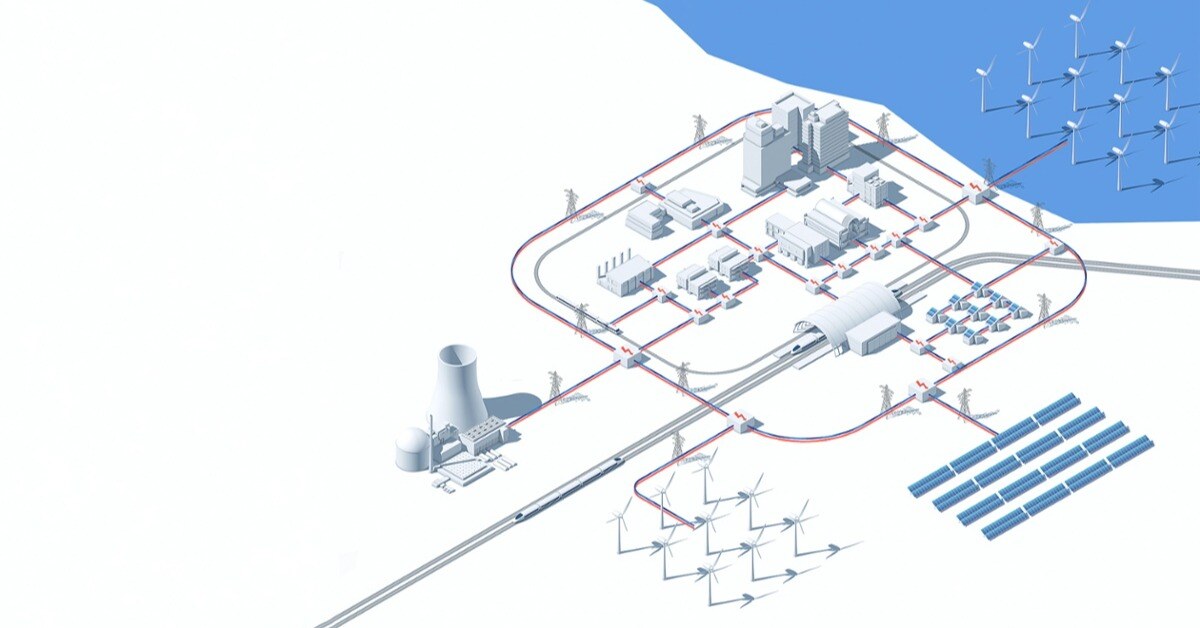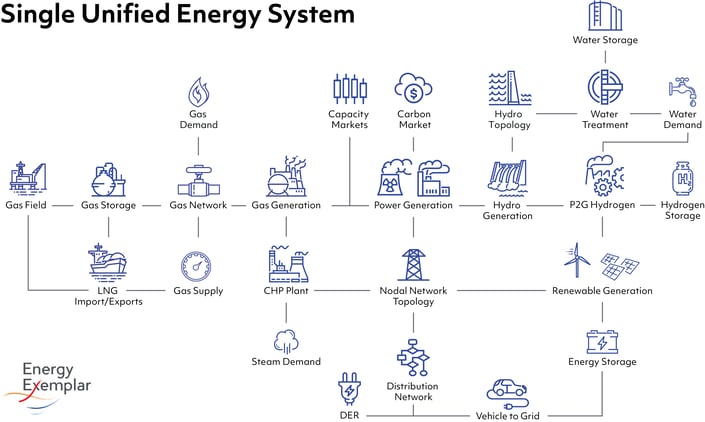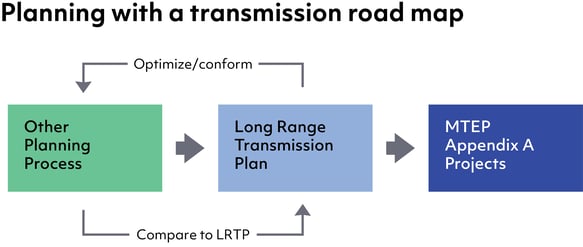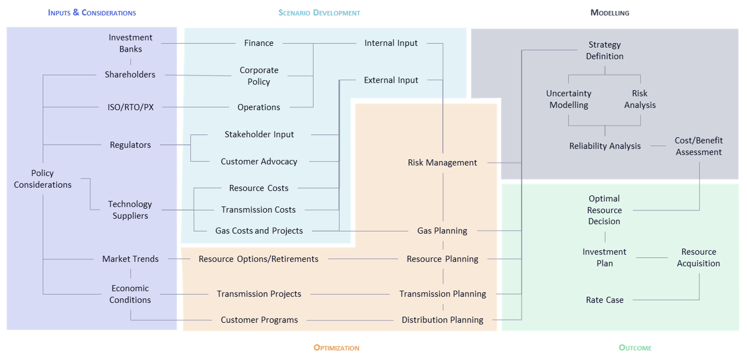The Imperative of Integrated System Planning
Originally published on Utility Dive on July 08, 2024 Generating and delivering energy to homes and businesses has never been a simple task. In...
10 min read
Talha Ali & Charles Banke : May 23, 2022

The energy landscape is rapidly evolving with the penetration of renewable resources, dynamically changing demand and the rapid electrification of adjacent industries such as transportation. Planning in this evolving landscape requires those in the energy industry to understand and answer questions that are far more complex than ever before, whether regulatory, market-driven, or stakeholder-driven. We need new and innovative approaches to revamp our current resource planning practices and provide a more comprehensive commodity view of the energy system to address these demands.
Traditional planning tools and methodologies for maintaining the electric grid are not capable of keeping up with the evolving changes. Utilities and planning committees realize that planning our energy system can no longer be done in silos, planning electricity generation and transmission separately from fuel sources such as gas or energy demand sectors such as water supply. Instead, we require a comprehensive approach that studies our energy system as an integrated, co-dependent system. The cost and availability of one resource directly impact the rest of the energy ecosystem's demand for availability. As new technologies are commercialized and introduced to the grid (i.e., hydrogen storage and electric vehicles), we must learn and understand their impact by looking at the system holistically as a single unified energy system.

With Integrated System Planning (ISP) – a new methodology that adopts an integrated and holistic planning process –planners can determine the optimal portfolio of build decisions. These considerations include generation resources, transmission and distribution systems, energy storage, renewables, vehicle to grid, hydrogen, water, heat, and gas systems. ISP unifies the planning, modeling, and optimization across multiple business units considering each corporate objective, regulatory requirement, customer preference, and emerging market trend.
Numerous drivers are pushing for the implementation of Integrated System Planning. Two of the most significant drivers are the State and Federal Regulating bodies that govern much of the energy industry in the United States. This regulatory push is happening both directly and indirectly.
An example of a direct call for a more integrated approach to planning would be Hawaii and the Hawaiian Electric Company (HECO). The public service commission of Hawaii requested HECO to combine their planning processes to produce a more holistic energy plan from the distribution up to the system level. The intention was to better integrate the planning processes due to the massive influx of distributed energy resources (DERs) that Hawaii was seeing installed on its grid. HECO has made great strides in the ISP space, discussed further below.
Indirect regulatory drivers for ISP are everywhere. Many states have decarbonization goals or a renewable portfolio standard (RPS) that regulated utilities must meet. California's passage of SB-100 in 2018 made it the first state requiring renewable energy and zero-carbon resources supply 100% of electric retail sales and end-use customers by 2045. Numerous states have followed in California's footsteps, targeting 100% clean energy over 30 years. The carbon reduction goals and mandates call for a substantial increase in the system's nameplate capacity, most of which will be variable energy resources (VERs) such as wind, solar, and battery energy storage. With a substantial increase in system capacity comes the challenge of delivering that energy reliably via the transmission and distribution system.
Similarly, state mandates for demand-side resources are proliferating across the country. The increase in penetration of customer-sited resources changes the dynamic of the planning paradigm. There are no longer days when utilities can solely plan for large utility-scale resources delivered from a generation center to a load center. Now utilities must plan for generation at the feeder level, customer's solar and battery installations, and reverse flow on lines that historically only flowed one direction. Although this could be solved in a silo in distribution planning, ISP enables customer-sited resource decisions and distribution investment/deferral to be co-optimized with the utility-scale resource and transmission decisions.
The Federal Energy Regulatory Commission (FERC) has also made note of the shortcomings of the existing transmission regulations and their impact on the planning process. FERC has released an Advanced Notice of Proposed Rule making (ANOPR) to address many issues currently being seen in the transmission world. Specifically, FERC is asking for feedback on managing cost allocation, interconnection processes, and the depth of the interconnection queues. They are exploring the evolution of the energy landscape – acknowledging the distinctive characteristics of variable energy resources (VERs) (i.e., wind, solar, tidal, and hydro power generation) and the decentralization of energy infrastructure. With this exploration, they are rethinking interconnection policies to improve the efficiency of the interconnection process. This could help speed up the existing slow study work process, expediting the construction and implementation of VERs on the grid. With FERC acknowledging the changing energy and planning landscape, this is another example of an indirect call for ISP.
The drivers are not only limited to regulation; significant market changes such as the decommissioning of thermal power generation, increase in renewables, energy storage technologies, and transmission constraints also necessitate the need for an integrated system planning approach.
On the resource side, the electric grid faces the retirement of many thermal generation facilities as coal powerplants are decommissioned over the next 20 years. In 2022 alone, 14.9 gigawatts (GW) of electric generating capacity are set to retire in the United States alone. These thermal resources are being replaced with renewable resources, primarily by solar photovoltaics and wind turbine generators (both onshore and offshore) which bring cleaner energy to the consumers. However, new renewable resources bring new technical challenges to the existing grid due to their intermittent nature. With the increase in intermittent resources in the system, peak hour studies are becoming less instrumental, and the need for stochastic modeling studies is becoming critical for system planning.
Energy storage solutions are rapidly expanding across the grid. These energy storage additions further the need for Integrated System Planning as these resources are connected at both the transmission and distribution levels, increasing the need for improved system planning to deliver power to the load centers.
The transmission system is aging and is a limiting factor in transporting energy as the distance between the resource pockets and the demand pockets continue to grow, resulting in grid congestion. Better system planning is needed to optimize and plan the transmission system as these renewable resources are added to the grid.
Finally, demand is also becoming more dynamic as we see increased levels of electrification, and demand response programs are becoming more prevalent. We see new types of loads introduced on the grid which are straining the transmission system. Electric vehicles are increasing rapidly and can act as a load or a load resource. Fifty-one percent of US adults say they will consider purchasing an electric vehicle in the next decade. Energy demand from crypto mining is expected to grow in parts of the U.S. markets, and it being an easily relocatable industry with high power demand, crypto introduces new complexities to planning studies. Current estimates of crypto mining place its energy consumption between 0.4% and 1% of global electricity usage. Consumer preferences on how their energy is procured and delivered have changed. Distributed generation has increased as consumers add rooftop solar and battery storage to residential and commercial buildings.
The underlying elements that tie the above mentioned factors are reliability, affordability, and sustainability. We have seen the consequences of disjoint energy planning when climate change and, more importantly, an influx of extreme weather events (i.e., extreme freezing weather events, increasing wildfires) are observed more often and can bring the system down, affecting millions of people's lives.
Learn what integrated system planning (ISP) is, how ISP differs from integrated resource planning (IRP), and the 3 key components required to make the change to ISP.
Various entities throughout the United States have approached Integrated System Planning in unique ways. Most observed integrated system planning involved collaboration between an organization's resource planning group and transmission planning group working on both near and long-term horizons. The examples discussed below demonstrate how various utilities approach the ISP processes.
California is one of the prime examples of clean energy implementation. With aggressive carbon-free targets, California has been adding renewables faster than any other state. This massive influx of VERs is catalyzing the ISP movement in California.
Although the state has not adopted a formal ISP process, they are beginning to make strides toward an integrated approach to planning. A giant step in this journey was California introducing the 20-year transmission plan in early 2022. This extended transmission plan aims to create a baseline to establish expectations for longer-term transmission planning. The 20-year plan is more conceptual, addressing the concerns of long lead times and aging infrastructure, and recognizes that it will need to be flexible, as resource planning will differ from procurement decisions. In parallel with the 20-year transmission plan, the current 10-year tariff-based plan will continue. The 20-year plan is not intended to replace the 10-year plan.
Another step in the right direction for California is the introduction of the resource' busbar mapping'. CAISO has begun aggregating Load Serving Entities (LSEs) and IRP portfolios and mapping the new resource options to specific busbars (also called nodes). This granular approach will feed into the broader transmission planning process at CAISO, which will allow for a better view into the future of California's transmission grid. Also important to note is that this busbar mapping will be an iterative approach, allowing for feedback from the transmission study to inform resource selection and location changes.
The midwestern United States, primarily covered by MISO, is currently experiencing a rapid expansion of renewables. MISO's interconnection queue through 2026 has approximately 14 GW of storage capacity, an estimated 81 GW of solar PV, and about 15 GW of wind resources. Its decreasing capacity of firm generation and increasing penetration of renewable resources in the region has led to increased levels of intermittent generation, impacting both the planning and operations teams at MISO.
Further, as the midwestern United States experiences increased renewable penetration in its rich resource pockets, with MISO’s southern coverage area experiencing high solar penetration and MISO’s northern coverage area experiencing high wind penetration, the system is becoming constrained as the distance between the load centers and these rich resource pockets increases. These changes create transmission planning challenges due to their large fluctuations in intermittent resources and cause marked changes in transmission flows, resulting in greater lengths of time congestion occurs.
As a result of these changes, MISO has begun to re-evaluate its planning strategy to ensure the reliability of its growing system needs. Addressing the transmission limitations as firm capacity retires and renewable generation grows, MISO created a Long-Range Transmission Plan to invest in the most optimal projects as MISO's grid evolves.

The Long-Range Transmission Plan (LRTP) is based on collaboration with MISO's resource planning processes. The LRTP serves as a roadmap for MISO by providing the guidance to make informed investment decisions that addresses MISO's near-term need while ensuring flexibility to evolve long-term requirements as customer preferences change and the capacity to decarbonize grows, accelerating the transition from its current fleet to achieving clean energy goals.
Identifying the transmission needs in the MISO region involves a multistep process. This process includes siting future resources and studying several future scenarios to identify transmission issues. These serve as critical inputs into the LRTP and are inputs to identify subregional problems. Solutions are chosen to ensure they meet grid reliability and resilience goals, regulatory objectives, and growing resource adequacy needs.
Hawaii is an excellent example of integrating the utility planning processes; the island state is blazing the trail for the rest of the country to follow. In 2017 the Hawaiian Electric Company (HECO) began conceptualizing what they call Integrated Grid Planning (IGP). The inception of IGP was both due to state regulatory pressure and internal needs. With support from regulators and stakeholders, HECO has constructed a framework over the last several years to support the integration of resource, transmission, and distribution planning. Their IGP framework considers both supply and demand side resources, transmission, distribution, resiliency, resource adequacy, customer programs and rate analysis. It is the most comprehensive ISP structure in the country.
This process aims to produce near-term actions that more fully coordinate and optimize customer resources and grid-scale resources while simultaneously improving the reliability and resiliency of the grid in a manner that benefits all customers. With this goal in mind, stakeholder and community engagement for HECO is paramount to their success, which is common to utility planning departments across the country. Customer support in this process is particularly critical, with a significant level of rooftop solar penetration in HECO's service territory.
Like the other use case examples, HECO is not fully co-optimizing their ISP process. However, the modeling framework they have put together utilizes an iterative approach, with feedback loops every step of the way. HECO's modeling approach begins with a capacity expansion model that feeds into the utility scale and distribution level analysis for reliability and planning purposes. HECO then runs a production cost model from the utility scale reliability analysis, which combines with their distribution analysis.
Interestingly, HECO takes it one step further and runs the portfolio through a system security analysis to ensure plans meet transmission criteria. At the end of each stage, HECO has a feedback loop that checks if the requirements for success are met, and if not, the process restarts with a new set of inputs.
For now, this iterative approach works well and produces good results using multiple modeling tools, but this highlights the need for the next level of integrated planning: a single tool to incorporate the entire planning process. HECO serves as an excellent example for the future of Integrated System Planning. As HECO constantly improves its methodology, utilities across the globe should keep an eye on their progress and be taking notes!
When thinking about Integrated System Planning, it is helpful to combine all the attributes into one big picture. It is essential to consider all aspects of an ISP across all business unit planning processes, including selecting the appropriate inputs & assumptions, developing the proper scenarios, conducting a full system optimization, and modeling uncertainties. Individual considerations for these components are described further in the schematic below.
Like Integrated Resource Planning, Integrated System Planning considers inputs and assumptions from various stakeholders and is driven by policies. These inputs and assumptions can come from regulators, ISOs, RTOs, investment banks, and technology suppliers. Examples of inputs vary from technology costs to commodity pricing (i.e., gas and coal prices), downtime, and other factors.
Various scenarios are developed from inputs and assumptions in the initial phase of the ISP to create applicable scenarios. Several scenarios may be designed for optimal portfolio development to understand the impact of various inputs.
The optimization phase of the ISP process is the single most critical part of the process, which differentiates from an IRP process. The optimization step considers not only resource planning but will consider gas planning, along with transmission and distribution planning to optimize the portfolio over the long-term horizon. Optimization ensures that planning is comprehensive and evaluates all aspects of the energy system rather than planning each element in separate silos.
Once the system is optimized across the various planning teams and business considerations, further stochastic analysis should be conducted to understand the uncertainty and risk to reliability associated with the resulting plans. Once a complete analysis like this is conducted, then a final set of optimal decisions can be produced and confidently acted upon.
Integrated System Planning will help utilities, ISOs, IPPs (Independent Power Producers), and stakeholders navigate the increasingly complex landscape where they need to consider more than traditional resources in resource planning. Integrating and optimizing the planning processes across the board generates a least-regret investment plan, considering the electric grid's cost, reliability, and cleanness.
Among the many benefits resulting from a holistic, integrated system planning process, three major areas that would be most impacted are reliability, cost efficiency, and a cleaner energy system.
ISP improves reliability on both the transmission and distribution levels as it looks at the system overall, rather than studying and planning for either distribution or transmission in silos to serve load or interconnect resources at both levels. It also addresses issues missed with the traditional siloed planning of commodities which are co-dependent on each other – such as how gas systems impact how the power market behaves as they are closely correlated. Understanding and planning for these interactions are needed to improve grid resiliency and reliability.
ISP improves our overall cost efficiency for both the resource providers and the consumers as we increase reliability overall. Only through a comprehensive analysis of the energy system will we find innovative ways to achieve cost efficiency. Battery storage serves as an excellent example. While not commonly factored into transmission planning, it offers a solution to defer transmission upgrades by decreasing congestion and improving grid stability.
Lastly, ISP helps utilities and planning groups achieve their clean energy goals through holistic system planning. As higher levels of renewables are introduced into the energy resource mix, we can meet most of the demand with renewables over the long-term horizon. Further, as thermal generation is retired and replaced with new clean resources, ISP enables us to effectively reach our clean energy goals.
Energy Exemplar is an industry leader in energy market simulation software. Our software suite, headlined by PLEXOS, is trusted by thousands of users around the world for a wide range of applications, from short-term analysis to long-term planning studies. Integrated across electricity, gas, and water systems, the PLEXOS platform provides exceptional decision insights to our customers.
Book a PLEXOS® demo today to get started.

Originally published on Utility Dive on July 08, 2024 Generating and delivering energy to homes and businesses has never been a simple task. In...

In some of our recent blogs, we discussed why there is a need for utilities and energy organizations to adopt a new planning methodology for...

In our last blog, we discussed the traditional method utilities and energy organizations have taken to planning – conducting multiple resource’s...